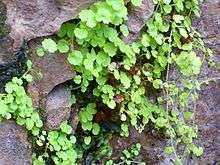Sibthorpia europaea
Sibthorpia europaea is a species of flowering plant known by the common name Cornish moneywort.[1] It can be found as a disjunct distribution in Western Europe from the Azores, Portugal and Spain to south-western Ireland and south-western United Kingdom. It also occurs in Crete, Pelion, Greece and tropical Africa. It is a prostrate perennial plant that is found in moist habitats.
| Sibthorpia europaea | |
|---|---|
 | |
| Scientific classification | |
| Kingdom: | Plantae |
| Clade: | Tracheophytes |
| Clade: | Angiosperms |
| Clade: | Eudicots |
| Clade: | Asterids |
| Order: | Lamiales |
| Family: | Plantaginaceae |
| Genus: | Sibthorpia |
| Species: | S. europaea |
| Binomial name | |
| Sibthorpia europaea | |
Taxonomy
The genus Sibthorpia is named after Dr Humphry Sibthorp who was the Sherardian Professor of Botany at the University of Oxford from 1747 to 1783.[2]
Description
Sibthorpia europaea is a small prostrate plant forming mats of thread-like stems which root as they creep across the ground. The mid-green hairy leaves are kidney-shaped and deeply notched. The flowers are tiny and develop singly in the leaf axils. They have relatively long stalks and five pinkish corolla-lobes, and appear from June onwards.[3]
Distribution and habitat
Sibthorpia europaea has a discontinuous distribution in Western Europe and tropical Africa. It is known from County Kerry in southwestern Ireland, South Wales, southwestern England,[4] and East Sussex,[3] Spain, Portugal, the Azores, Crete, Pelion (Greece) and tropical Africa. It may be that this unusual distribution represents remnants of a species that was more widespread in the Tertiary period.[4] It typically inhabits moist, shady locations such as stream-banks, the sides of ditches, woodland, wet heathland, shady path verges, lawns and old walls and banks with a thin covering of soil. In Ireland it grows at altitudes up to 515 m (1,690 ft) but populations seem to be dwindling as it faces competition from the more aggressive New Zealand willowherb.[5]
References
- "BSBI List 2007". Botanical Socieomyty of Britain and Ireland. Archived from the original (xls) on 2015-01-25. Retrieved 23 October 2016.
- Maton, William George (1797). Observations relative chiefly to the natural history, picturesque scenery and antiquities of the western counties of England, made in the years 1794 and 1796. London. p. 138.
- McClintock, David; Fitter, R.S.R. (1961). The Pocket Guide to Wild Flowers. Collins. p. 141.
- "Sibthorpia europaea L.: Cornish moneywort". NBN Atlas. Retrieved 20 March 2020.
- "Sibthorpia europaea". Online Atlas of the British and Irish flora. Retrieved 20 March 2020.
External links
